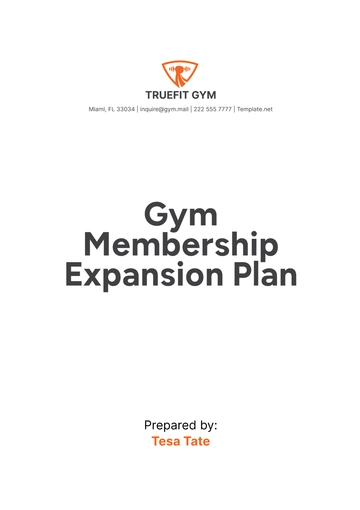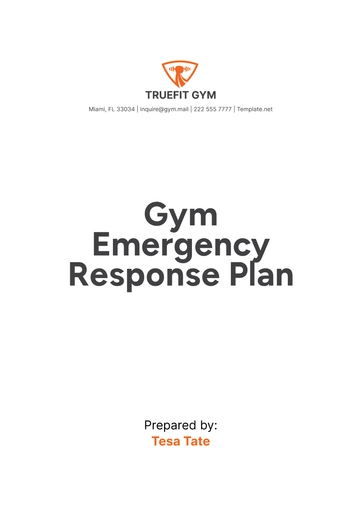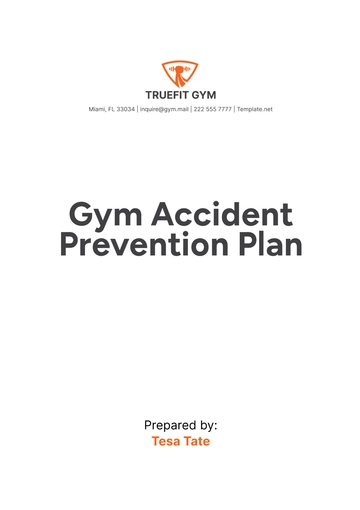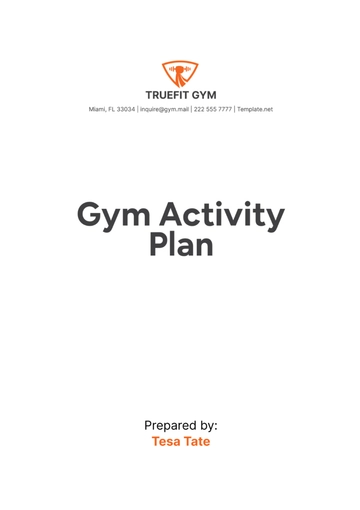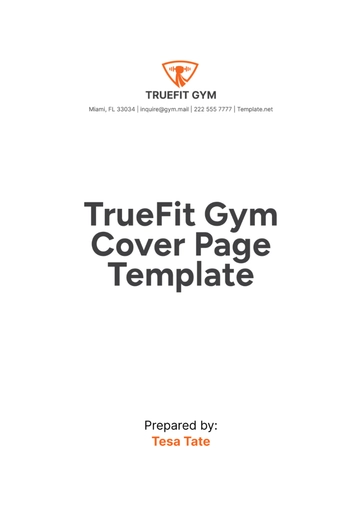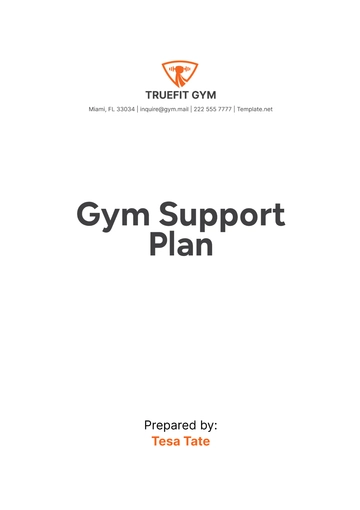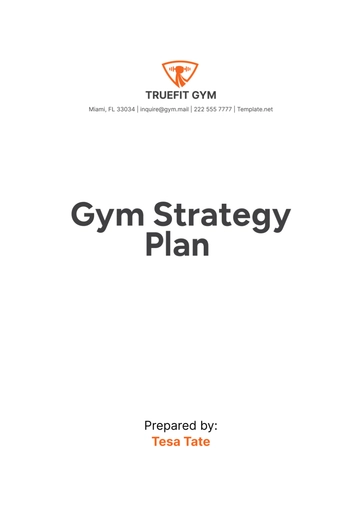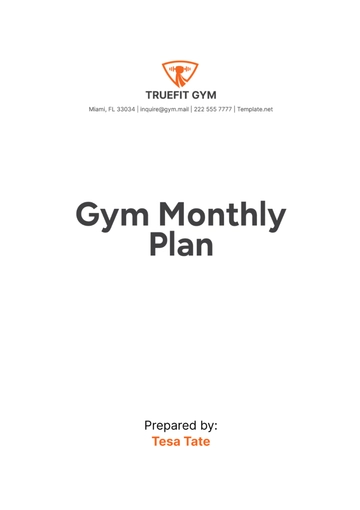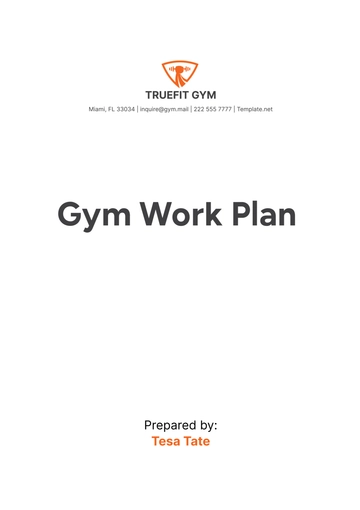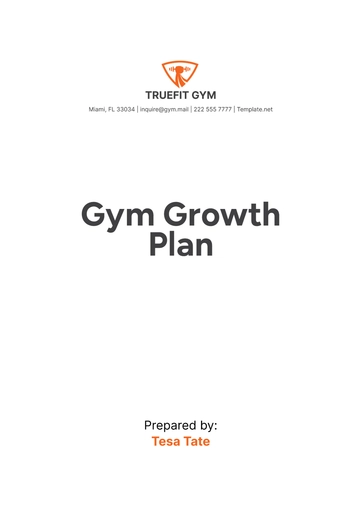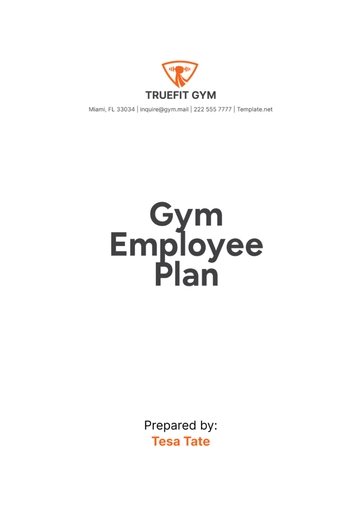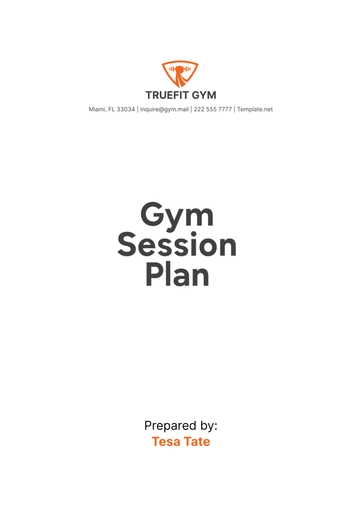Free Gym Activity Plan
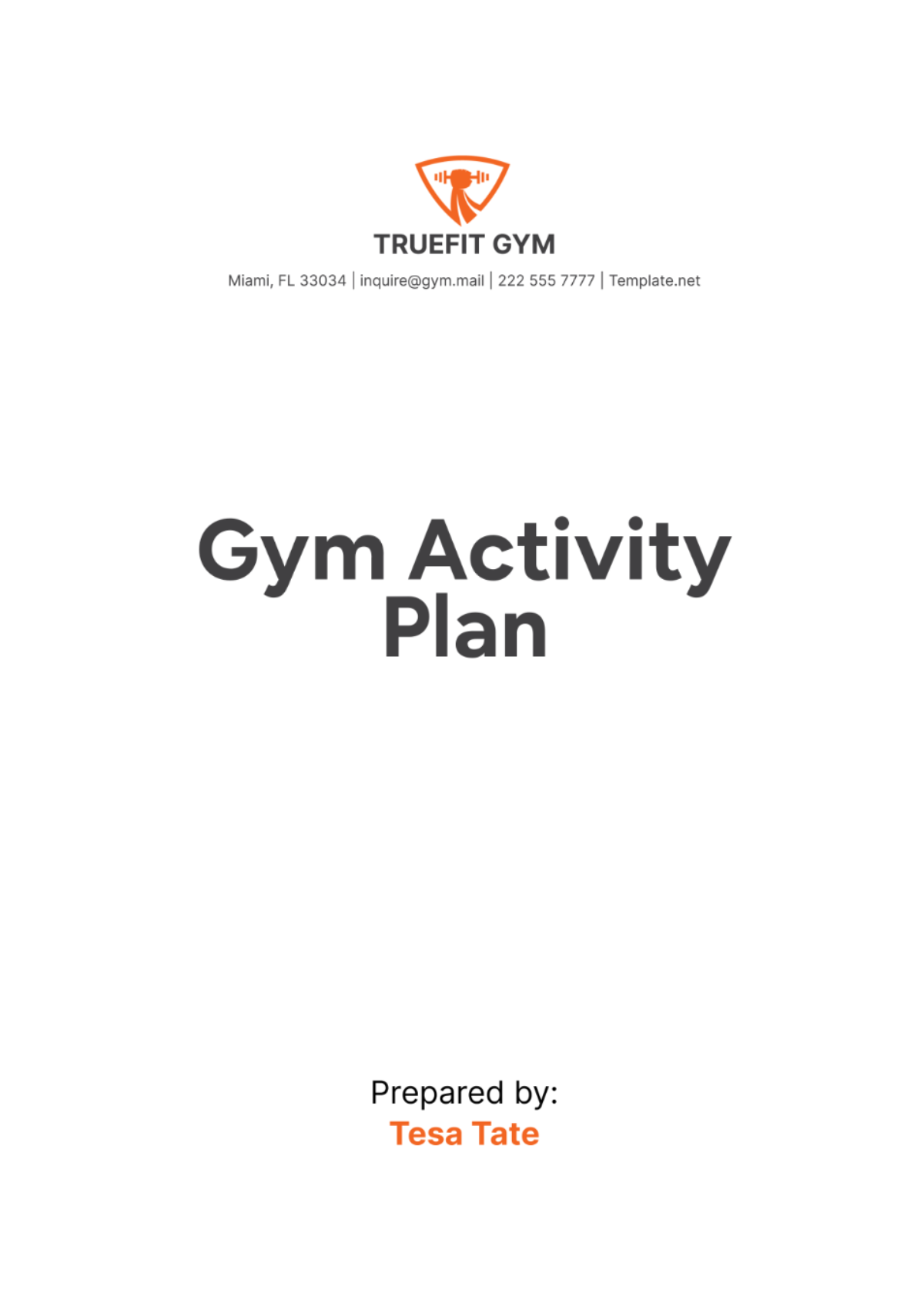
I. Introduction
A. Client Information
[Member's Name], [00] years old, is a software engineer with a sedentary lifestyle seeking to improve overall fitness and build muscle mass. He leads a busy life but is committed to dedicating three to four gym sessions per week to achieve his fitness goals.
B. Fitness Goals and Objectives
[Member's Name] aims to increase muscle strength and endurance, particularly in his legs, chest, and core. He also seeks to improve cardiovascular fitness to support better stamina and overall health. Additionally, he wants to enhance flexibility and mobility to prevent injuries and improve his range of motion in daily activities and sports.
II. Assessment and Evaluation
A. Initial Fitness Assessment
[Member's Name] underwent a comprehensive initial fitness assessment conducted by a certified personal trainer. His cardiovascular fitness assessment included VO2 max testing, where he achieved a score of 45 ml/kg/min, indicating above-average aerobic capacity for his age group. Submaximal treadmill tests further revealed that while [Member's Name] can sustain moderate intensity exercise well, he fatigues quicker during higher intensity efforts, suggesting a need to build aerobic endurance gradually through targeted training protocols.
B. Muscular Strength and Endurance
During strength assessments, [Member's Name] demonstrated noticeable strength imbalances between his upper and lower body. His 1-repetition maximum (1RM) tests for lower body exercises such as squats and deadlifts showed strengths and weaknesses that highlight the need for a balanced strength training program. Furthermore, endurance tests indicated areas where [Member's Name] fatigues more quickly, underscoring the importance of incorporating higher-repetition sets to enhance muscular endurance over time.
C. Flexibility and Mobility
[Member's Name]'s flexibility assessments revealed average range of motion in major muscle groups, with specific tightness observed in his hip flexors and shoulders. Mobility tests indicated adequate joint mobility but identified areas for improvement, particularly in dynamic flexibility needed for activities requiring rotational mobility and overhead movements. These assessment results inform the inclusion of targeted stretching routines and mobility drills in [Member's Name]'s workout plan, aiming to improve overall flexibility, reduce injury risk, and enhance functional movement patterns both in the gym and in daily life.
III. Warm-Up
A. General Warm-Up
[Member's Name] begins his warm-up routine with 10 minutes of brisk walking or light jogging on the treadmill to elevate his heart rate gradually and increase blood flow to his muscles. This helps prepare his cardiovascular system for the upcoming workout session. Following the aerobic warm-up, he incorporates dynamic stretches such as leg swings, arm circles, and torso twists to further increase muscle elasticity and joint mobility, focusing on movements that mimic the exercises he will perform during his main workout.
B. Specific Warm-Up
Before starting his resistance training session, [Member's Name] engages in specific warm-up exercises targeted at the muscle groups he will be working on. This includes bodyweight exercises like squats, lunges, and push-ups to activate his leg, core, and upper body muscles. Performing these movements with controlled technique helps prime his neuromuscular system for the heavier loads and more intense contractions he will experience during the workout. Additionally, he incorporates mobility drills such as hip openers and shoulder circles to improve joint range of motion and reduce the risk of injury during exercises like squats and overhead presses.
IV. Main Workout
A. Resistance Training
Exercise 1: Barbell Squats
[Member's Name] executes 3 sets of 10 repetitions with a weight set at 70% of his 1-repetition maximum (1RM). Each set is performed with proper form and technique, focusing on maintaining a controlled descent and powerful ascent to maximize muscle engagement. Rest periods between sets are crucial for adequate recovery, typically lasting 60-90 seconds to allow for replenishment of ATP stores and removal of metabolic byproducts.
Exercise 2: Dumbbell Bench Press
He completes 3 sets of 12 repetitions using moderate weights, ensuring full range of motion and proper alignment of shoulders, elbows, and wrists. Shorter rest periods of 45-60 seconds between sets help maintain muscle tension and metabolic stress, promoting muscle hypertrophy and endurance. Variations in grip width and angle of incline may be incorporated to target different areas of the chest and shoulders effectively.
B. Cardiovascular Exercise
Treadmill Running
[Member's Name] engages in 15 minutes of continuous running at a moderate pace (6-7 on the perceived exertion scale), aiming to improve cardiovascular endurance and burn calories efficiently. Adjustments in incline and speed can be made periodically to vary intensity and challenge different muscle groups, enhancing overall fitness levels. A 5-minute cooldown period follows, reducing heart rate gradually and aiding in the recovery process.
Stationary Bike
Alternating between 2 minutes at moderate intensity and 1 minute at high intensity over a 20-minute session, [Member's Name] performs interval training on the stationary bike. This method boosts cardiovascular fitness by alternating periods of increased effort with active recovery phases, optimizing calorie expenditure and improving anaerobic capacity. Monitoring heart rate and perceived exertion levels helps gauge intensity and adjust intervals accordingly for maximum benefit.
C. Flexibility and Mobility
Following the main workout, [Member's Name] dedicates time to static stretching exercises aimed at major muscle groups such as quadriceps, hamstrings, and hip flexors. Each stretch is held for 20-30 seconds, focusing on deep breathing and relaxing into the stretch to enhance muscle relaxation and flexibility. Incorporating dynamic stretches like leg swings and arm circles further improves joint range of motion and prepares muscles for future workouts.
Utilizing a foam roller for self-myofascial release, [Member's Name] targets tight areas such as calves, upper back, and IT bands. This technique promotes circulation, reduces muscle tension, and accelerates recovery by breaking down adhesions in the fascia. Adjusting pressure and rolling patterns allows for customized treatment of specific muscle groups, addressing any areas of soreness or stiffness effectively.
V. Cool Down
A. Gentle Cardiovascular Exercise
After completing his workout session, [Member's Name] dedicates an additional 5 to 10 minutes to engaging in light exercise on a low-resistance cardio machine, such as a stationary bike or an elliptical trainer. This period of moderate aerobic activity serves multiple beneficial purposes. Firstly, it helps in gradually lowering his heart rate in a controlled manner. Secondly, it enhances blood circulation throughout his body. This improved circulation aids in the efficient removal of metabolic waste products that may have accumulated in his muscles during the workout, thereby promoting overall recovery and reducing potential muscle soreness.
B. Static Stretching
[Member's Name] incorporates an extensive cool-down routine that specifically targets a thorough regimen of static stretches, each carefully selected to address the major muscle groups utilized during their workout. Within this deliberate cool-down phase, each stretch is meticulously held for a duration ranging from 20 to 30 seconds. This measured approach aims to enhance muscle elasticity and effectively mitigate the onset of post-exercise stiffness. By integrating controlled breathing techniques and a focus on relaxation, [Member's Name] significantly amplifies the efficacy of each stretch. This method not only fosters a smoother recovery for the muscles but also significantly lowers the risk of injury, ensuring a holistic and preventative approach to their physical fitness regimen.
C. Relaxation Techniques
In order to encourage mental relaxation and diminish stress levels, [Member's Name] dedicates time to practicing deep breathing exercises or immerses themselves in mindful meditation for a duration of 5 to 10 minutes after completing a workout session. This routine serves to soothe the nervous system, decrease cortisol levels, and significantly improve the overall recovery process following physical exertion.
VI. Progression and Adaptation
A. Tracking and Monitoring Progress
[Member's Name] maintains a detailed workout log to track key metrics such as weights lifted, repetitions performed, and perceived exertion levels for each exercise. Regularly reviewing these records allows him to monitor progress over time, identify trends in performance, and adjust his training regimen accordingly to continue making gains in strength, endurance, and flexibility.
B. Feedback and Adjustments
Based on his progress assessments and feedback from workouts, [Member's Name] makes informed adjustments to his training program. This includes modifying exercise intensity, volume, and frequency to ensure continued progression and prevent plateaus. Consulting with his personal trainer or fitness coach helps [Member's Name] fine-tune his workouts based on individual responses to training stimuli, optimizing results and maintaining motivation towards achieving his fitness goals.
VI. Progression and Adaptation
A. Tracking and Monitoring Progress
[Member's Name] keeps a detailed workout journal where he records not only his exercise routines and weights used but also notes on how each session felt, including perceived exertion and any discomfort or fatigue. This allows him to track improvements in strength, endurance, and flexibility over time, providing valuable insights into his fitness journey. By regularly reviewing his progress, [Member's Name] can identify areas where he's excelling and areas that may require more focus or adjustment in his training approach.
B. Feedback and Adjustments
[Member's Name] actively seeks feedback from his personal trainer or coach based on his progress assessments and workout journal entries. This collaborative approach ensures that his training program remains dynamic and responsive to his evolving fitness levels and goals. Adjustments may include tweaking exercise intensity, varying workout formats, or introducing new techniques to challenge different muscle groups and prevent training plateaus. Regular communication with his trainer also helps [Member's Name] stay motivated and accountable, fostering a positive training environment that supports continuous improvement.
VII. Nutrition and Hydration
A. Pre-Workout Nutrition
Before workouts, [Member's Name] focuses on consuming a balanced meal rich in complex carbohydrates, lean proteins, and healthy fats. This provides sustained energy for his training session and supports muscle function and recovery. Examples include a chicken breast with quinoa and vegetables, or a smoothie with Greek yogurt, fruits, and oats.
B. Post-Workout Nutrition and Recovery
Immediately after workouts, [Member's Name] prioritizes replenishing glycogen stores and facilitating muscle repair and growth by consuming a combination of protein and carbohydrates. This may include a protein shake or a meal consisting of lean protein (e.g., salmon or tofu) with a side of complex carbohydrates (e.g., sweet potatoes or brown rice). Adequate hydration is also crucial to replace fluids lost through sweat and support nutrient transport and cellular function.
C. Hydration Guidelines
Throughout the day, [Member's Name] ensures he stays hydrated by drinking water consistently. He aims to consume at least 8-10 glasses of water daily, adjusting intake based on exercise intensity and environmental conditions. Proper hydration supports optimal performance during workouts, helps regulate body temperature, and promotes overall health and well-being.
VIII. Schedule and Frequency
A. Weekly Workout Schedule
[Member's Name] follows a structured workout schedule that includes resistance training sessions on Monday, Wednesday, and Friday, focusing on different muscle groups each day. Tuesdays and Thursdays are dedicated to cardiovascular workouts such as running or cycling, while Saturdays are reserved for active recovery activities like yoga or swimming. Sundays serve as rest days to allow for full muscle recovery and prevent overtraining.
B. Recommended Frequency of Workouts
Based on his fitness goals and current fitness level, [Member's Name] aims for 3-4 strength training sessions per week, supplemented with 2-3 cardiovascular sessions and 1-2 sessions of flexibility and mobility work. This balanced approach ensures he targets all aspects of fitness—strength, endurance, flexibility, and cardiovascular health—while allowing adequate time for recovery and adaptation.
C. Rest Days and Active Recovery
Recognizing the importance of rest in his fitness regimen, [Member's Name] values his rest days as crucial for muscle repair and growth. Active recovery sessions on weekends involve low-intensity activities that promote circulation, reduce muscle soreness, and enhance flexibility. These sessions also contribute to mental relaxation and overall well-being, preparing him for another productive week of training.
IX. Additional Recommendations
A. Lifestyle Factors
In addition to exercise and maintaining a balanced diet, [Member's Name] places a high emphasis on sleep as an essential aspect of his comprehensive fitness routine. He strives to achieve between seven to eight hours of restful sleep every night, which he recognizes as crucial for promoting muscle recovery, regulating hormones, and enhancing cognitive abilities. Furthermore, [Member's Name] actively engages in managing stress by employing techniques such as meditation or immersing himself in hobbies. These practices significantly contribute to his broader objectives of health and fitness, supporting his overall well-being.
B. Supplementary Activities
To complement the workouts he performs regularly in the gym, [Member's Name] finds enjoyment in participating in occasional group fitness classes. These classes can include High-Intensity Interval Training, often referred to by its acronym, HIIT, as well as yoga sessions. In addition to these indoor options, [Member's Name] also partakes in outdoor activities, which might involve hiking along nature trails or cycling through scenic routes.
Engaging in these varied physical activities adds a refreshing variety to his overall fitness routine. Not only do they challenge different muscle groups that might not be worked as intensely during his typical gym sessions, but they also offer valuable opportunities for social interaction. This social aspect provides him with additional motivation, making his fitness journey more enjoyable and holistic.
- 100% Customizable, free editor
- Access 1 Million+ Templates, photo’s & graphics
- Download or share as a template
- Click and replace photos, graphics, text, backgrounds
- Resize, crop, AI write & more
- Access advanced editor
Manage your fitness journey efficiently with the Gym Activity Plan Template from Template.net. This editable and customizable template, equipped with an intuitive AI Editor Tool, simplifies crafting personalized workout routines. Tailor exercises, track progress, and optimize results seamlessly. Whether boosting strength or enhancing flexibility, achieve your fitness goals effectively with this versatile tool.
You may also like
- Finance Plan
- Construction Plan
- Sales Plan
- Development Plan
- Career Plan
- Budget Plan
- HR Plan
- Education Plan
- Transition Plan
- Work Plan
- Training Plan
- Communication Plan
- Operation Plan
- Health And Safety Plan
- Strategy Plan
- Professional Development Plan
- Advertising Plan
- Risk Management Plan
- Restaurant Plan
- School Plan
- Nursing Home Patient Care Plan
- Nursing Care Plan
- Plan Event
- Startup Plan
- Social Media Plan
- Staffing Plan
- Annual Plan
- Content Plan
- Payment Plan
- Implementation Plan
- Hotel Plan
- Workout Plan
- Accounting Plan
- Campaign Plan
- Essay Plan
- 30 60 90 Day Plan
- Research Plan
- Recruitment Plan
- 90 Day Plan
- Quarterly Plan
- Emergency Plan
- 5 Year Plan
- Gym Plan
- Personal Plan
- IT and Software Plan
- Treatment Plan
- Real Estate Plan
- Law Firm Plan
- Healthcare Plan
- Improvement Plan
- Media Plan
- 5 Year Business Plan
- Learning Plan
- Marketing Campaign Plan
- Travel Agency Plan
- Cleaning Services Plan
- Interior Design Plan
- Performance Plan
- PR Plan
- Birth Plan
- Life Plan
- SEO Plan
- Disaster Recovery Plan
- Continuity Plan
- Launch Plan
- Legal Plan
- Behavior Plan
- Performance Improvement Plan
- Salon Plan
- Security Plan
- Security Management Plan
- Employee Development Plan
- Quality Plan
- Service Improvement Plan
- Growth Plan
- Incident Response Plan
- Basketball Plan
- Emergency Action Plan
- Product Launch Plan
- Spa Plan
- Employee Training Plan
- Data Analysis Plan
- Employee Action Plan
- Territory Plan
- Audit Plan
- Classroom Plan
- Activity Plan
- Parenting Plan
- Care Plan
- Project Execution Plan
- Exercise Plan
- Internship Plan
- Software Development Plan
- Continuous Improvement Plan
- Leave Plan
- 90 Day Sales Plan
- Advertising Agency Plan
- Employee Transition Plan
- Smart Action Plan
- Workplace Safety Plan
- Behavior Change Plan
- Contingency Plan
- Continuity of Operations Plan
- Health Plan
- Quality Control Plan
- Self Plan
- Sports Development Plan
- Change Management Plan
- Ecommerce Plan
- Personal Financial Plan
- Process Improvement Plan
- 30-60-90 Day Sales Plan
- Crisis Management Plan
- Engagement Plan
- Execution Plan
- Pandemic Plan
- Quality Assurance Plan
- Service Continuity Plan
- Agile Project Plan
- Fundraising Plan
- Job Transition Plan
- Asset Maintenance Plan
- Maintenance Plan
- Software Test Plan
- Staff Training and Development Plan
- 3 Year Plan
- Brand Activation Plan
- Release Plan
- Resource Plan
- Risk Mitigation Plan
- Teacher Plan
- 30 60 90 Day Plan for New Manager
- Food Safety Plan
- Food Truck Plan
- Hiring Plan
- Quality Management Plan
- Wellness Plan
- Behavior Intervention Plan
- Bonus Plan
- Investment Plan
- Maternity Leave Plan
- Pandemic Response Plan
- Succession Planning
- Coaching Plan
- Configuration Management Plan
- Remote Work Plan
- Self Care Plan
- Teaching Plan
- 100-Day Plan
- HACCP Plan
- Student Plan
- Sustainability Plan
- 30 60 90 Day Plan for Interview
- Access Plan
- Site Specific Safety Plan
